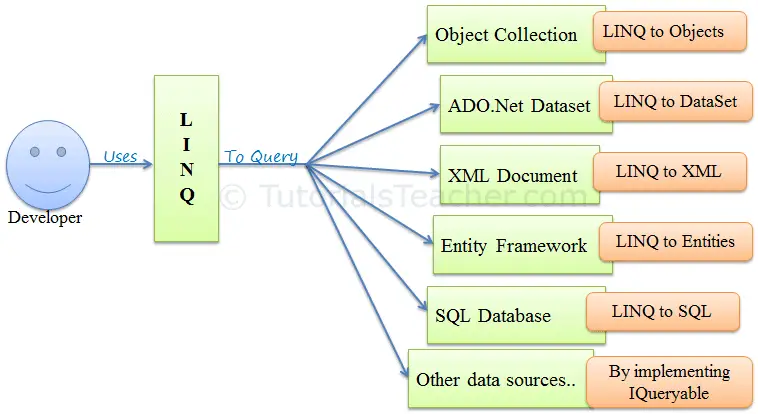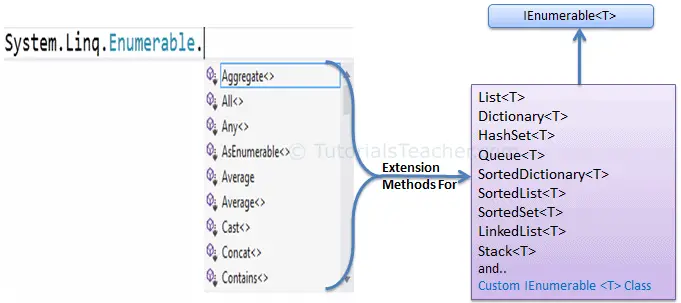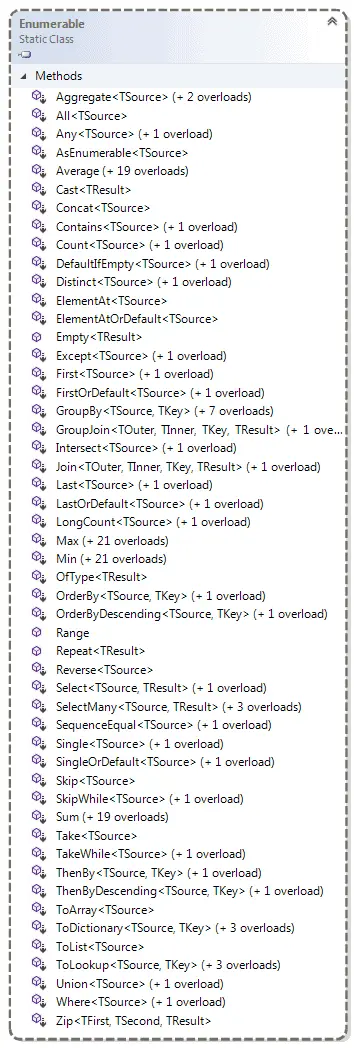Linq
LINQ :Language-Integrated Query is a powerful query language introduced with .Net 3.5 & Visual Studio 2008.
LINQ (Language Integrated Query) is uniform query syntax in C# and VB.NET to retrieve data from different sources and formats such as collections, ADO.Net DataSet, XML Docs, web service and MS SQL Server and other databases.

LINQ queries return results as objects.
Refrences:https://www.tutorialsteacher.com/linq/why-linq


LINQ (Language Integrated Query) is uniform query syntax in C# and VB.NET to retrieve data from different sources and formats such as collections, ADO.Net DataSet, XML Docs, web service and MS SQL Server and other databases.

LINQ queries return results as objects.
Refrences:https://www.tutorialsteacher.com/linq/why-linq
Advantages of LINQ
- Familiar language: Developers don’t have to learn a new query language for each type of data source or data format.
- Less coding: It reduces the amount of code to be written as compared with a more traditional approach.
- Readable code: LINQ makes the code more readable so other developers can easily understand and maintain it.
- Standardized way of querying multiple data sources: The same LINQ syntax can be used to query multiple data sources.
- Compile time safety of queries: It provides type checking of objects at compile time.
- IntelliSense Support: LINQ provides IntelliSense for generic collections.
- Shaping data: You can retrieve data in different shapes.
LINQ API : System.Linq
LINQ queries uses extension methods for classes that implement


IEnumerable or IQueryable interface. The Enumerable and Queryable are two static classes that contain extension methods to write LINQ queries.Enumerable :
IEnumerable is an interface defining a single method GetEnumerator() that returns an IEnumerator interface. It is the base interface for all non-generic collections that can be enumerated. This works for read-only access to a collection that implements that IEnumerable can be used with a foreach statement.
- IEnumerable<T> type of collections are in-memory collection like List, Dictionary, SortedList, Queue, HashSet, LinkedList.
The Enumerable class includes extension methods for the classes that implement
IEnumerable<T> interface, for example all the built-in collection classes implement IEnumerable<T> interface and so we can write LINQ queries to retrieve data from the built-in collections.
Extension Methods:

I expect foreach works on lists because they implement IEnumerable.
IEnumerable is an interface defining a single method GetEnumerator() that returns an IEnumerator interface. It is the base interface for all non-generic collections that can be enumerated. This works for read-only access to a collection that implements that IEnumerable can be used with a foreach statement.
Queryable
The Queryable class includes extension methods for classes that implement IQueryable<t> interface. The
IQueryable<T> interface is used to provide querying capabilities against a specific data source where the type of the data is known.Reference:
IEnumerable VS IQueryable
IEnumerable
- IEnumerable exists in System.Collections Namespace.
- IEnumerable can move forward only over a collection, it can’t move backward and between the items.
- IEnumerable is best to query data from in-memory collections like List, Array, etc.
- While query data from a database, IEnumerable execute a select query on the server side, load data in-memory on a client-side and then filter data.
- IEnumerable is suitable for LINQ to Object and LINQ to XML queries.
- IEnumerable supports deferred execution.
- IEnumerable doesn’t support custom query.
- IEnumerable doesn’t support lazy loading. Hence not suitable for paging like scenarios.
- Extension methods support by IEnumerable takes functional objects.
IEnumerable Example
- MyDataContext dc = new MyDataContext ();
- IEnumerable<Employee> list = dc.Employees.Where(p => p.Name.StartsWith("S"));
- list = list.Take<Employee>(10);
Generated SQL statements of the above query will be :
- SELECT [t0].[EmpID], [t0].[EmpName], [t0].[Salary] FROM [Employee] AS [t0]
- WHERE [t0].[EmpName] LIKE @p0
Notice that in this query "top 10" is missing since IEnumerable filters records on the client side
IQueryable
- IQueryable exists in System. Linq Namespace.
- IQueryable can move forward only over a collection, it can’t move backward and between the items.
- IQueryable is best to query data from out-memory (like remote database, service) collections.
- While query data from a database, IQueryable execute the select query on the server side with all filters.
- IQueryable is suitable for LINQ to SQL queries.
- IQueryable supports deferred execution.
- IQueryable supports custom query using CreateQuery and Execute methods.
- IQueryable support lazy loading. Hence it is suitable for paging like scenarios.
- Extension methods support by IQueryable takes expression objects means expression tree.
IQueryable Example
MyDataContext dc = new MyDataContext ();
IQueryable<Employee>list=dc.Employees.Where(p=> p.Name.StartsWith("S"));
list = list.Take<Employee>(10);
Generated SQL statements of the above query will be :
SELECT TOP 10 [t0].[EmpID], [t0].[EmpName], [t0].[Salary] FROM [Employee] AS [t0]
WHERE [t0].[EmpName] LIKE @p0
LINQ Query Syntax :
- Query Syntax or Query Expression Syntax
- Method Syntax or Method Extension Syntax or Fluent.
Query Syntax:
The LINQ query syntax starts with from keyword and ends with select keyword.

LINQ Method Syntax:
Method syntax (also known as fluent syntax) uses extension methods included in the Enumerable or Queryable static class.

the signature of the Where extension method, you will find the Where method accepts a predicate delegate as Func<Student, bool>.
A lambda expression is a block of code (an expression or a statement block) that is treated as an object. It can be passed as an argument to methods, and it can also be returned by method calls.
Lambda expressions are code that can be represented either as a delegate, or as an expression tree that compiles to a delegate. The specific delegate type of a lambda expression depends on its parameters and return value.
Standard Query Operators
Standard Query Operators in LINQ are actually extension methods for the
IEnumerable<T> and IQueryable<T> types. They are defined in the System.Linq.Enumerable and System.Linq.Queryable classes. There are over 50 standard query operators available in LINQ that provide different functionalities like filtering, sorting, grouping, aggregation, concatenation, etc.| Filtering Operators | Description |
|---|---|
| Where | Returns values from the collection based on a predicate function |
| OfType | Returns values from the collection based on a specified type. However, it will depend on their ability to cast to a specified typ |
We can use where clause or .where extension method and can use multiple where in both.
The OfType operator filters the collection based on the ability to cast an element in a collection to a specified type.
The OfType operator filters the collection based on the ability to cast an element in a collection to a specified type.
var stringResult = mixedList.OfType<string>();- The Where operator filters the collection based on a predicate function.
- The OfType operator filters the collection based on a given type
- Where and OfType extension methods can be called multiple times in a single LINQ query.
| Sorting Operator | Description |
|---|---|
| OrderBy | Sorts the elements in the collection based on specified fields in ascending or decending order. |
| OrderByDescending | Sorts the collection based on specified fields in descending order. Only valid in method syntax. |
| ThenBy | Only valid in method syntax. Used for second level sorting in ascending order. |
| ThenByDescending | Only valid in method syntax. Used for second level sorting in descending order. |
| Reverse | Only valid in method syntax. Sorts the collection in reverse order. |
extension method:
OrderByDescending:
var studentsInDescOrder = studentList.OrderByDescending(s => s.StudentName);
Multiple Sorting
You can sort the collection on multiple fields seperated by comma.
var orderByResult = from s in studentList
orderby s.StudentName, s.Age
Sorting Operators: ThenBy & ThenByDescending :
- OrderBy and ThenBy sorts collections in ascending order by default.
- ThenBy or ThenByDescending is used for second level sorting in method syntax.
- ThenByDescending method sorts the collection in decending order on another field.
- ThenBy or ThenByDescending is NOT applicable in Query syntax.
- Apply secondary sorting in query syntax by separating fields using comma.
Grouping Operators Description GroupBy The GroupBy operator returns groups of elements based on some key value. Each group is represented by IGrouping<TKey, TElement> object. ToLookup ToLookup is the same as GroupBy; the only difference is the execution of GroupBy is deferred whereas ToLookup execution is immediate.
var groupedResult = from s in studentList
group s by s.Age;var groupedResult = studentList.GroupBy(s => s.Age);Join
The Join operator operates on two collections, inner collection & outer collection. It returns a new collection that contains elements from both the collections which satisfies specified expression. It is the same as inner join of SQL.
Method Syntax:
var innerJoin = studentList.Join(// outer sequence
standardList, // inner sequence
student => student.StudentID, // outerKeySelector
standard => standard.StandardID, // innerKeySelector
(student, standard) => new // result selector
{
StudentName = student.StudentName,
StandardName = standard.StandardName
});Query Syntax:var innerJoin = from s in studentList // outer sequence
join st in standardList //inner sequence
on s.StandardID equals st.StandardID // key selector
select new { // result selector
StudentName = s.StudentName,
StandardName = st.StandardName
};
The GroupJoin operator performs the same task as Join operator except that GroupJoin returns a result in group based on specified group key.
Method Syntax:
var groupJoin = standardList.GroupJoin(studentList, //inner sequence
std => std.StandardID, //outerKeySelector
s => s.StandardID, //innerKeySelector
(std, studentsGroup) => new // resultSelector
{
Students = studentsGroup,
StandarFulldName = std.StandardName
});
//Query Syntaxvar groupJoin = from std in standardList
join s in studentList
on std.StandardID equals s.StandardID
into studentGroup
select new {
Students = studentGroup ,
StandardName = std.StandardName
};
Select : The Select operator always returns an IEnumerable collection which contains elements based on a transformation function.
var selectResult = from s in studentList
select new { Name = "Mr. " + s.StudentName, Age = s.Age }; var selectResult = studentList.Select(s => new { Name = s.StudentName ,
Age = s.Age });
Quantifier Operators:
Aggregation Operators: Aggregate:
| Method | Description |
|---|---|
| Aggregate | Performs a custom aggregation operation on the values in the collection. |
| Average | calculates the average of the numeric items in the collection. |
| Count | Counts the elements in a collection. |
| LongCount | Counts the elements in a collection. |
| Max | Finds the largest value in the collection. |
| Min | Finds the smallest value in the collection. |
| Sum | Calculates sum of the values in the collection. |
Aggregate method that returns comma seperated elements of the string list.
The Aggregate method performs an accumulate operation.
var commaSeperatedString = strList.Aggregate((s1, s2) => s1 + ", " + s2);Average extension method calculates the average of the numeric items in the
collection.
The Count operator returns the number of elements in the collection or
number of elements that have satisfied the given condition.
The Max operator returns the largest numeric element from a collection.
The Sum() method calculates the sum of numeric items in the collection.
lement Operators (Methods) Description ElementAt Returns the element at a specified index in a collection ElementAtOrDefault Returns the element at a specified index in a collection or a default value if the index is out of range. First Returns the first element of a collection, or the first element that satisfies a condition. FirstOrDefault Returns the first element of a collection, or the first element that satisfies a condition. Returns a default value if index is out of range. Last Returns the last element of a collection, or the last element that satisfies a condition LastOrDefault Returns the last element of a collection, or the last element that satisfies a condition. Returns a default value if no such element exists. Single Returns the only element of a collection, or the only element that satisfies a condition. SingleOrDefault Returns the only element of a collection, or the only element that satisfies a condition. Returns a default value if no such element exists or the collection does not contain exactly one element.
If your result set returns many records:
SingleOrDefault throws an exceptionFirstOrDefault returns the first record
For LINQ -> SQL:
SingleOrDefault
- will generate query like "select * from users where userid = 1"
- Select matching record, Throws exception if more than one records found
- Use if you are fetching data based on primary/unique key column
FirstOrDefault
- will generate query like "select top 1 * from users where userid = 1"
- Select first matching rows
- Use if you are fetching data based on non primary/unique key column
Equality Operator: SequenceEqual
There is only one equality operator: SequenceEqual. The SequenceEqual method checks whether the number of elements, value of each element and order of elements in two collections are equal or not.
To compare the values of two collection of complex type (reference type or object),
you need to implement IEqualityComperar<T> interface
The Concat() method appends two sequences of the same type
Method Description Empty Returns an empty collection Range Generates collection of IEnumerable<T> type with specified number of elements with sequential values, starting from first element. Repeat Generates a collection of IEnumerable<T> type with specified number of elements and each element contains same specified value.
et Operators Usage Distinct Returns distinct values from a collection. Except Returns the difference between two sequences, which means the elements of one collection that do not appear in the second collection. Intersect Returns the intersection of two sequences, which means elements that appear in both the collections. Union Returns unique elements from two sequences, which means unique elements that appear in either of the two sequences.
Method Description Skip Skips elements up to a specified position starting from the first element in a sequence. SkipWhile Skips elements based on a condition until an element does not satisfy the condition. If the first element itself doesn't satisfy the condition, it then skips 0 elements and returns all the elements in the sequence. Take Takes elements up to a specified position starting from the first element in a sequence. TakeWhile Returns elements from the first element until an element does not satisfy the condition. If the first element itself doesn't satisfy the condition then returns an empty collection.
Method Description AsEnumerable Returns the input sequence as IEnumerable<t> AsQueryable Converts IEnumerable to IQueryable, to simulate a remote query provider Cast Coverts a non-generic collection to a generic collection (IEnumerable to IEnumerable<T>) OfType Filters a collection based on a specified type ToArray Converts a collection to an array ToDictionary Puts elements into a Dictionary based on key selector function ToList Converts collection to List ToLookup Groups elements into an Lookup<TKey,TElement>
To Operators: ToArray(), ToList(), ToDictionary()
As the name suggests, ToArray(), ToList(), ToDictionary() method converts a source object into an array, List or Dictionary respectively.
To operators force the execution of the query. It forces the remote query provider to execute a query and get the result from the underlying data source e.g. SQL Server database.
Read below link data
References:https://www.tutorialsteacher.com/linq/linq-deferred-execution
Comments
Post a Comment